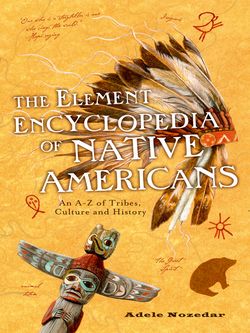Читать книгу The Element Encyclopedia of Native Americans: An A to Z of Tribes, Culture, and History - Adele Nozedar - Страница 60
BLACKFOOT CONFEDERACY
ОглавлениеAlso called the Siksika, meaning “Blackfoot,” or the Niitsitapi, meaning “original people.” Blackfoot/Niitsitapi is the name of a confederacy of tribes: the North Piegan, the South Piegan, the Siksika, and the Kainai. All these tribes belonged to the Algonquian language family. The entire group were large and renowned for their ferocity in battle, second only to the Dakota in size and importance. The Confederacy also gave protection to two smaller bands, the Sarsi and the Atsina, or Gros Ventre. Like the Blackfeet Sioux—a completely different tribe—the Blackfoot, legendarily, were meant to have been given their name after their moccasins were stained black from prairie fires. These moccasins—which had a beadwork design featuring three prongs—made the Blackfoot immediately recognizable.
The Blackfoot ranged over a large territory, from the North Saskatchewan River in what is now Canada to the Yellowstone River in Montana, and from the Rockies to the Alberta—Saskatchewan border. Having adopted the horse from other Plains tribes, they roamed after the buffalo and lived in tipis in settlements of up to 250 people in up to 30 lodges. Each small band had its leader, and relationships between bands were flexible enough for members to come and go between bands as they pleased. In the summer the bands gathered together; they were among those who performed the Sun Dance ritual. In addition, the Blackfoot had another spectacular ritual: the Horse Dance ceremony.
The natural enemies of the Blackfoot included the Crow, Sioux, Shoshone, and Nez Perce; their most particular enemy, though, came in the form of an alliance of tribes who came under the name of the Iron Confederacy. They would travel long distances to take part in raids on other tribes. A young Blackfoot boy on his first such raid was given a derogatory name until he had killed an enemy or stolen a horse, when he was given a name that carried honor with it. Like other Native Americans, a lack of immunity to the most common European diseases had brought tragedy to the Blackfoot for many years; in one of the worst incidents, in 1837, some 6,000 Blackfoot perished when smallpox was contracted from European passengers on a steamboat.
During the protracted winter months, the camps of Blackfoot hunkered down, perhaps camping together when stores were adequate. The buffalo were easier to hunt during the winter, simple to track through the snow. Hunting took place when other resources were beginning to run low. For the Blackfoot as well as other Native American peoples, the buffalo was an essential part of their lifestyle. However, deliberate overhunting by the Europeans in an attempt to weaken the Natives by taking away their primary resource meant that, from the 1880s onward, the Blackfoot had to adopt new ways of survival. The Canadian members of the Confederacy were appointed reservations in southern Alberta in the late 1870s, which saw them struggle as they faced many hardships connected with a completely new way of life after generations of roaming freely. The Blackfoot were forced to turn to the white man for help, relying on the U.S. Government for food supplies, which were very often not forthcoming or rotten and inedible. The tribe were forced to turn to theft, which resulted in counterattacks from the Army; these attacks often saw women and children killed.
The worst winter, 1883–1884, “Starvation Winter,” was so-called because not only were there no buffalo, but no supplies from the Government. Approximately 600 Blackfoot perished.
